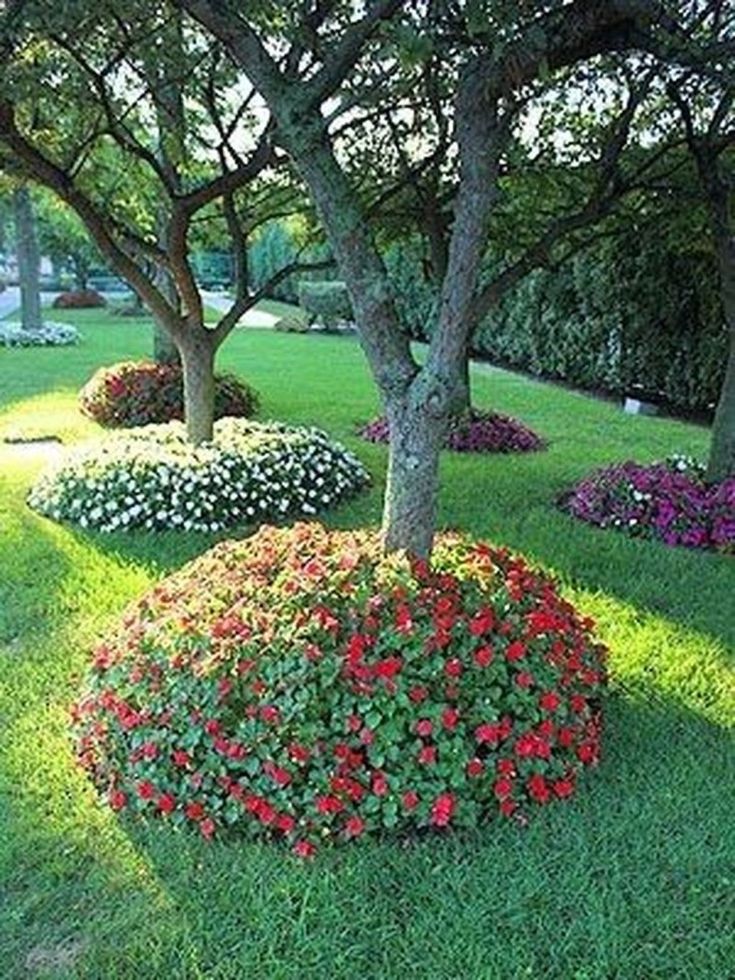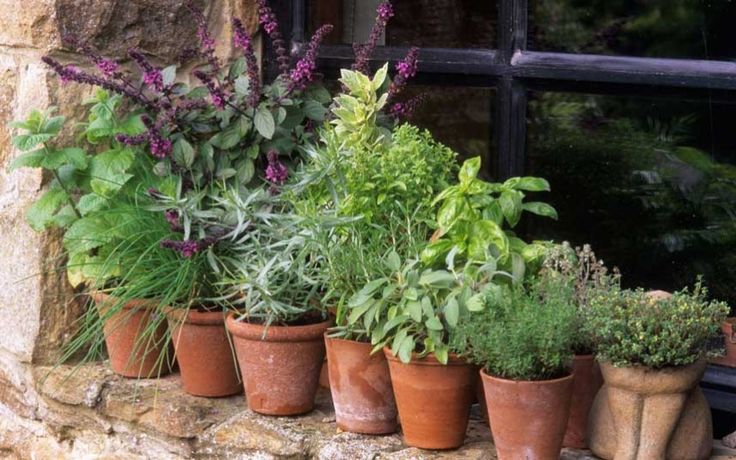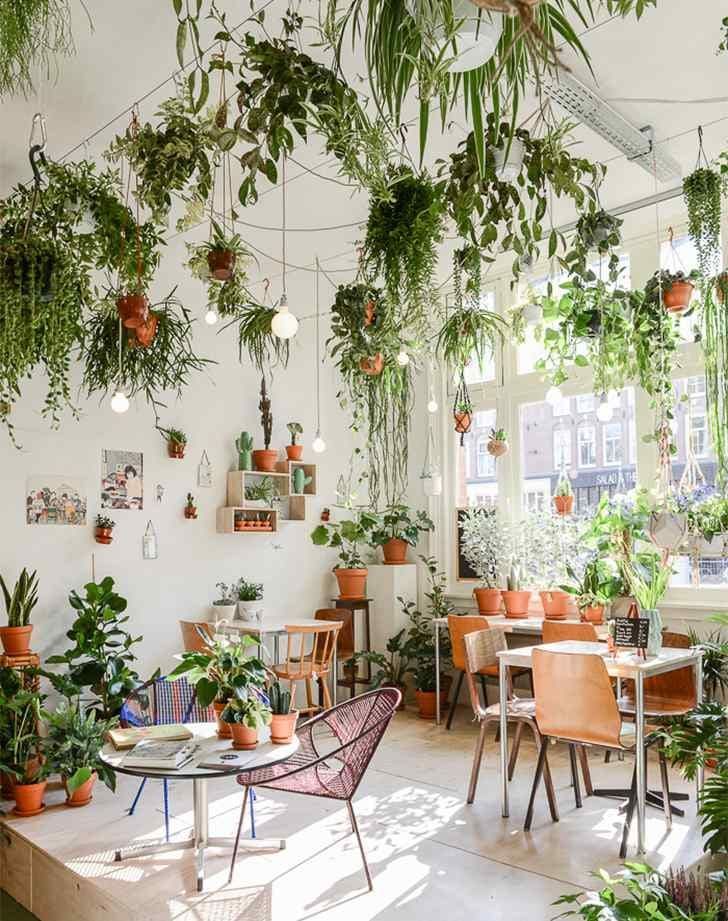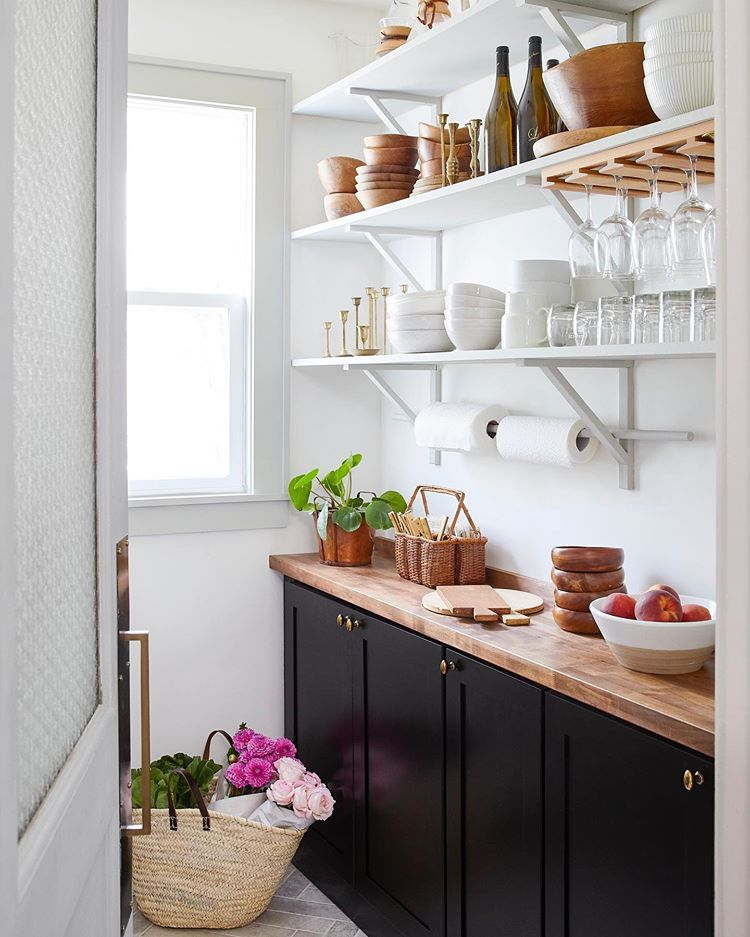Garden designs around trees
Landscaping around trees – 10 stunning ideas
(Image credit: Susie Watson Designs)
Landscaping around trees has seen a real progression in recent years. Gone are the days of simply edging your tree with bricks or covering the exposed soil with gravel. Instead, there are plenty of colorful and architectural ideas to add character to your backyard ideas, rather than just dressing with stones, slate or bark.
If you're wondering where to start, these 10 ideas for landscaping around trees are sure to spark inspiration.
Landscaping around trees
Whether you're looking to add landscaping interest around large trees – such as some of the best trees for privacy and screening – or simply want to add color to trees grown in pots, there are so many options. These are our favorite ideas for landscaping around trees.
1. Underplant trees with bulbs to create seasonal interest
(Image credit: Leigh Clapp)
Landscaping around trees can add interest even when the tree is bare. In fact, early bulbs will grow before the tree is in full leaf so you don't need to worry about battling with shade. Of course, underplanting a tree is not straightforward as there's a concern for damaging the tree's roots.
Before you start, be sure to throughly mulch the base of the tree with organic matter, this will give you space to plant the bulbs without damaging the roots.
'To have a succession of different bulbs from January to May, plant a variety, from the early blooming snowdrops, winter aconites and crocuses, through snowflakes, fritillaries and narcissi, to tulips, alliums, and camassias.' advises garden expert Leigh Clapp 'Muscari or grape hyacinths naturalize well under trees and shrubs. Mix with primroses, daffodils, pansies and early tulips for a pretty combination'.
Once planted, your bulbs will continue to grow, multiply and reappear each year, making them a low-maintenance way to add floral landscaping around trees. Plus, as the bulbs disappear back underground once they've finished blooming, you can still mulch, feed and water your trees as needed.
2. Create a relaxing spot by adding a bench
(Image credit: Susie Watson Designs)
Adding a circular bench around a large tree not only invites a shady spot to rest in but also provides a point of visual interest to the whole garden scheme. A fairly straightforward idea for landscaping around trees, there are many companies that craft beautiful benches for trees, from wooden designs that add classic country charm to ornate cast-iron designs that have an antique-feel and add traditional elegance to your space.
You can even get personalized designs that make for a beautiful gift and are sure to stay in the family for generations.
3. Use the shade provided by trees for an al fresco dining space
(Image credit: Future / Emma Lee)
If you're looking for garden shade ideas that are useful as well as attractive, utilize the shade a tree provides by creating an al fresco dining space underneath.
'Your outdoor space should be a place for you, your family and your friends to enjoy. With this in mind, treat your garden like you would your home and fill your space with accessories that reflect your personality. Think about your concept, furniture and accessories to create a space that feels like a room,' Scarlett Blakey, interior design expert at Ophelia Blake .
With this in mind, treat your garden like you would your home and fill your space with accessories that reflect your personality. Think about your concept, furniture and accessories to create a space that feels like a room,' Scarlett Blakey, interior design expert at Ophelia Blake .
4. Frame trees with hedging for an natural yet ordered look
(Image credit: Future )
Create a sense of order in your garden by landscaping around trees with a low hedge border. Neatly manicured, it frames the space and harks back to formal parterre designs.
Framing your trees with box or privet hedging will add visual interest and serve to contain the bed into which your trees are growing – particularly if you've used a loose mulch like bark chippings or slate to suppress weeds.
This look works particularly well if used over a larger area – rather than around one specific tree – and to disguise the seam between two different ground materials, such as lawn and plant border or path and plant border.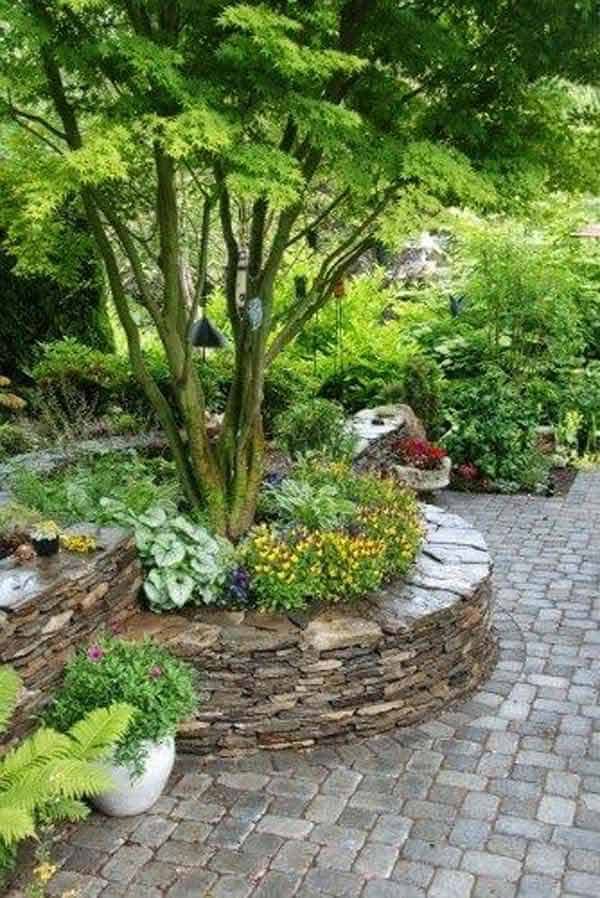
5. Contain planting by adding a raised border
(Image credit: Future / Polly Eltes)
Constructing a border around your tree will mean that you can raise the level of the soil around the trunk. Doing this not only provides valuable nutrition to the tree but also allows you to underplant without damaging the roots of the tree. What's more, it creates an organized aesthetic that works well with a manicured lawn or alongside a gravelled drive.
6. Build a patio around the tree
(Image credit: Future)
Patio areas have been increasingly popular additions to our gardens, offering a low-maintenance space for al fresco dining, entertaining and relaxing. If you are looking for patio ideas, considering adding or extending a patio, then it is good to know that you can incorporate large trees into your design.
However, there are a few things to bear in mind. Your trees roots will run under the area you are planning on paving. If your tree is old and its roots system well established, then the roots are unlikely to cause you any serious issues. However, it the tree is younger, be aware that they may cause disturbance to the patio in the future as the roots grow. Consider raising the level of the patio by lining with a few inches of extra sand to help buffer the roots.
However, it the tree is younger, be aware that they may cause disturbance to the patio in the future as the roots grow. Consider raising the level of the patio by lining with a few inches of extra sand to help buffer the roots.
Pavers are also a better choice when building a patio over tree roots as they are more flexible than alternatives like poured concrete. This way if there is any movement, the pavers can easily be relaid, something that is more difficult with concrete patios.
7. Incorporate the tree into your decking
(Image credit: Future/Mark Bolton)
Deck ideas are great for landscaping around trees; in the long-term they are also the lowest maintenance, too. Adding a decked area to your garden opens it up to a whole host of design opportunities. A softer alternative to paving, it harmonizes with trees and planting to create the perfect space for relaxing.
By surrounding the base of the tree, you don't have to worry about weeds, while the added height of the deck also means that the tree's roots are very unlikely to have an impact on the stability of the deck as they grow.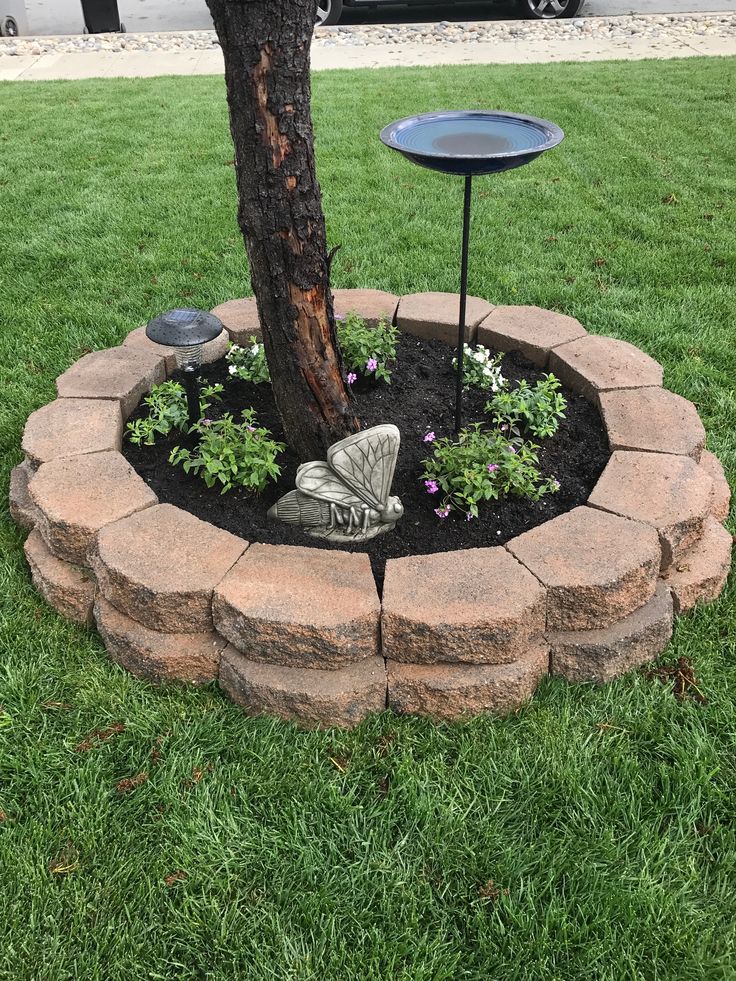
8. Consider landscaping around espaliered trees
(Image credit: Leigh Clapp)
Espaliered trees are trained to grow against a wall and as such have a large, rectangular border around the base. Since the tree is flat to the wall, the area beneath it is less shaded than under a conventional tree.
Opt for plants with shallow roots for landscaping around trees as they will not disturb the root system of the tree. Lavender, zinnias, pansies and marigolds are all great choices for underplanting trees.
9. Create a peaceful oasis by positioning a swimming pool under your tree
(Image credit: Courtesy of Joseph Richardson Landscape Architecture)
Embrace the serenity of the natural world and create your own spa at home by using tall trees to frame an infinity pool. Landscaping around trees this way provides pool landscaping ideas that are private and shaded, and also offers a relaxing backdrop to your leisurely swim.
10. Welcome nature by encouraging a meadow to grow under your trees
(Image credit: Future/Max A Rush)
Cutting grass under trees is a challenge, often requiring you switch off the mower and cut it by hand.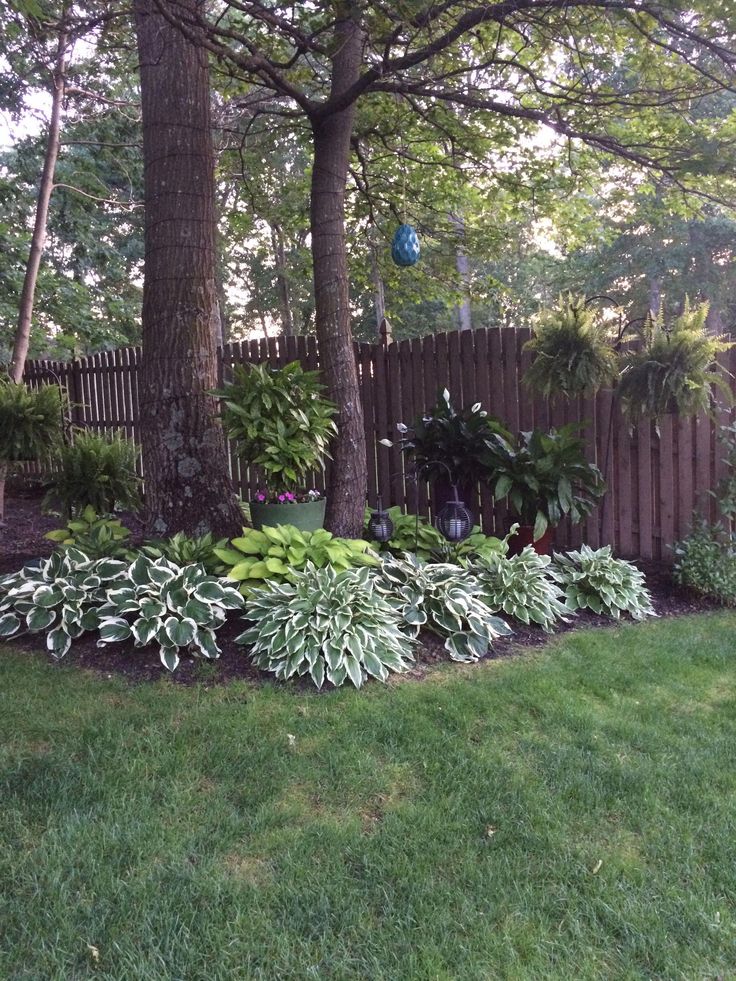 However, letting the grass grow longer at the base of your trees eradicates this struggle while also giving back to nature. Why not go a step further and make wildflower seeds bombs to scatter underneath? Pick a seed mix that comprises poppies, sweet alyssum, cosmos and evening primroses, it will quickly transform your backyard into one packed with wildlife garden ideas.
However, letting the grass grow longer at the base of your trees eradicates this struggle while also giving back to nature. Why not go a step further and make wildflower seeds bombs to scatter underneath? Pick a seed mix that comprises poppies, sweet alyssum, cosmos and evening primroses, it will quickly transform your backyard into one packed with wildlife garden ideas.
What is the best thing to put around the base of a tree?
Shade loving plants or bulbs are the best thing to put around the base of a tree for an easy and instant fix. Hostas, dicentra and primoses are all shade loving plants that will add a burst of greenery below your tree, plus will all produce stunning flowers. Alternatively, ferns are an evergreen choice that will create a rustic, woodland feel to your garden. Interplant with erythronium to add colorful blooms come summer.
'When planting beneath trees, remove any weeds and scratch the surface of the soil with a garden fork, as the soil can be very compacted, taking care not to damage any roots,' advises PL garden expert Leigh Clapp, 'select shade-loving plants with compact root systems so they don’t compete with the tree for nutrients and pay attention to watering and fertilising as plants establish.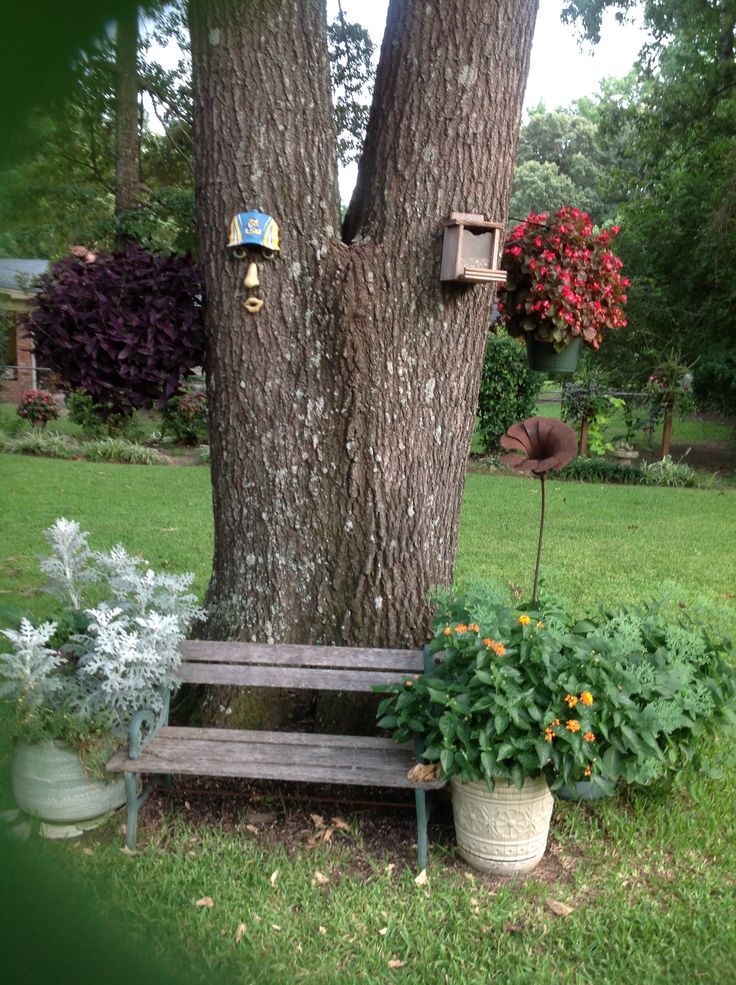 '
'
What to put around trees to prevent weeds?
You can put everything from a gravel or bark mulch to building a decking around a tree to prevent weeds.
While weed suppressant fabrics are good for preventing weeds, they make it difficult to feed and fertilize your tree, so it is not a good idea if your tree is young and still needs lots of support to grow. Alternative options for young trees include top dressing with bark chippings which will decay over time and provide the tree with nourishment. Another option is to allow a wildflowers meadow to grow as when the wildflowers meadow is established, it will naturally suppress the weeds.
For larger trees, you can afford to cover their root system a little more as they won't be as dependent on fertilizer and organic mulch (though this is still good for them from time to time). Consider building a decking or patio around the base of the tree to create a relaxing space that will also be weed-free.
Having graduated with a first class degree in English Literature four years ago, Holly started her career as a features writer and sub-editor at Period Living magazine, Homes & Gardens' sister title.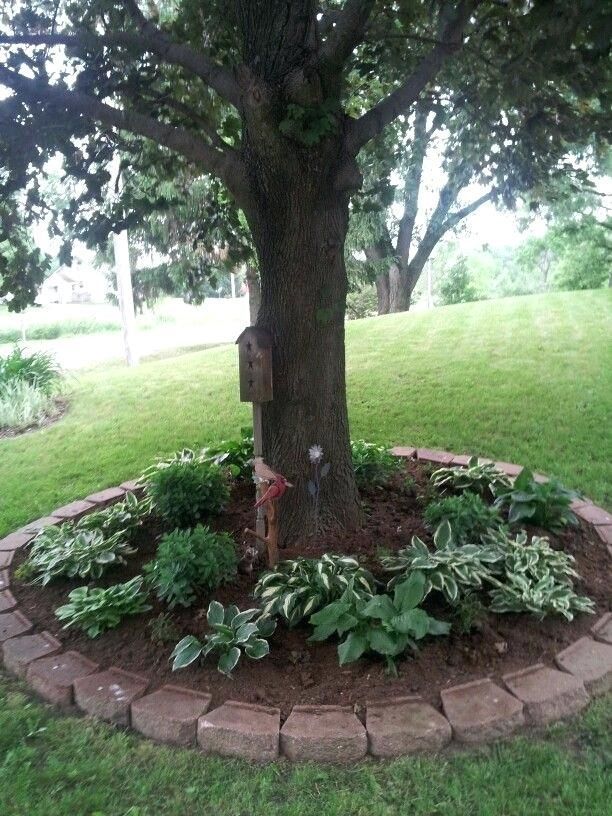 Working on Period Living brought with it insight into the complexities of owning and caring for period homes, from interior decorating through to choosing the right windows and the challenges of extending. This has led to a passion for traditional interiors, particularly the country-look. Writing for the Homes & Gardens website as a content editor, alongside regular features for Period Living and Country Homes & Interiors magazines, has enabled her to broaden her writing to incorporate her interests in gardening, wildlife and nature.
Working on Period Living brought with it insight into the complexities of owning and caring for period homes, from interior decorating through to choosing the right windows and the challenges of extending. This has led to a passion for traditional interiors, particularly the country-look. Writing for the Homes & Gardens website as a content editor, alongside regular features for Period Living and Country Homes & Interiors magazines, has enabled her to broaden her writing to incorporate her interests in gardening, wildlife and nature.
15 Ideas for Landscaping Around Trees
By
Lisa Hallett Taylor
Lisa Hallett Taylor
Lisa Hallett Taylor is an expert in architecture and landscape design who has written more than 1,000 articles about pool, patio, garden, and home improvement over 12 years. She has a bachelor's degree in Environmental Design and is certified in fine and decorative arts appraisal.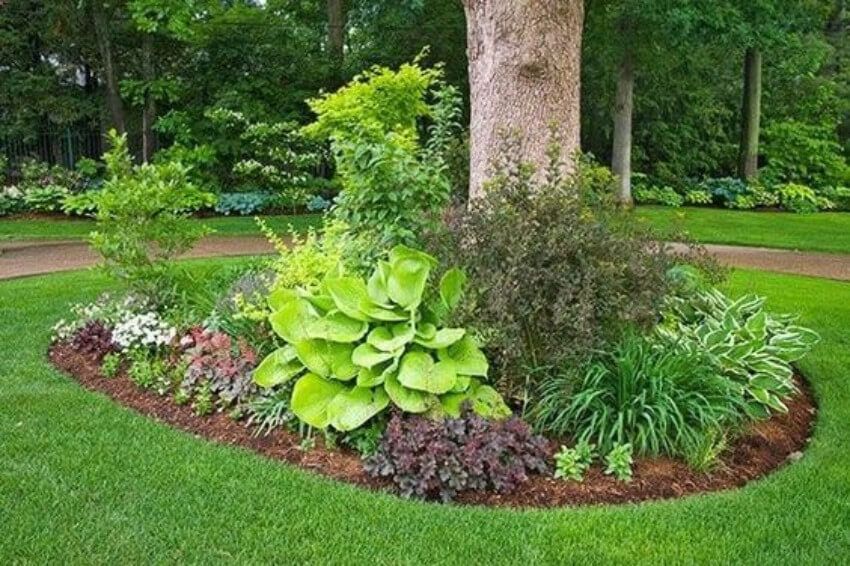
Learn more about The Spruce's Editorial Process
Updated on 03/18/21
The Spruce / Michelle Becker
The ground underneath and surrounding a tree is often neglected, resulting in bare dirt, exposed tree roots, and a few volunteer plants that aren't necessarily welcome. Discover ways to landscape a forgotten area that will make the tree and what it shades much more appealing.
Finding a solution isn't a one-size-fits-all scenario. There's a concern for damaging the tree's roots, dealing with dry soil, irrigation (too much or too little), shade, limited space (those roots!), and dappled light. Keep in mind that not all landscaping requires plants: hardscape in the form of decks, gravel, or mulch might be just the right fix.
The traditional way of landscaping beneath or around a tree was to edge it in brick, stone, or rubber. If you wanted to get creative, you'd plant impatiens, begonias, and maybe a few shade-tolerant bulbs—until the area became overrun with weeds, the snails and slugs invaded, or it started to look just plain bad. The results are often surprising: you don't expect something to be planted in these spaces, but once they are, you realize that it's unused real estate that is just waiting to be beautified.
The results are often surprising: you don't expect something to be planted in these spaces, but once they are, you realize that it's unused real estate that is just waiting to be beautified.
Get inspired by these smart and beautiful ways to landscape under and around a tree.
-
01 of 15
Tree With Hanging Chair
Eric Staudenmaier/ Halo Interior Design/ HouzzThis massive, 80-year-old coral tree (Erythrina) in Orange County, California, had been neglected before the current owners bought the property. To retain its beauty, the tree requires quarterly shaping and lacing by an arborist. Easy-care ferns are planted underneath. The real attraction of the yard, designed by Halo Interior Design, is the hanging chair, which draws attention to those sculptural branches.
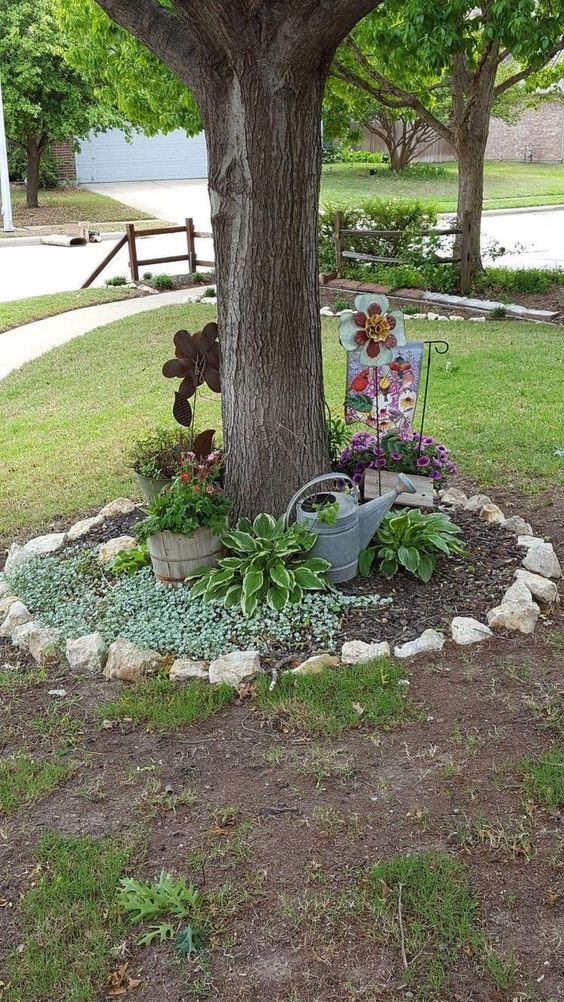 Irregular slate pavers and grass are underneath the chair and branches.
Irregular slate pavers and grass are underneath the chair and branches. Coral trees are primarily found in Southern California and Hawaii and are admired for their beautiful flowers that grow in colors ranging from greenish white to yellow to vivid shades of orange and red.
-
02 of 15
Calming Cohesive Garden
Stephen Suzman/Zeterre Landscape ArchitectureA brilliant lime green Japanese maple tree, Koto No Ito, is surrounded by a labyrinth of boxwood hedges, heuchera, and Korean no-mow grass. Designed by Zeterre Landscape Architecture, this garden in Oakland, California, was created over a 15-year time period. The goal: to create five distinct gardens within the property that are tied by a common taste and materials that complement the home's architecture. The low wall was constructed with New Haveli limestone in aqua from Rhodes Architectural Stone.
Japanese maple trees are valued for their small-to-medium size, making them ideal for raised beds, large containers, and patios.
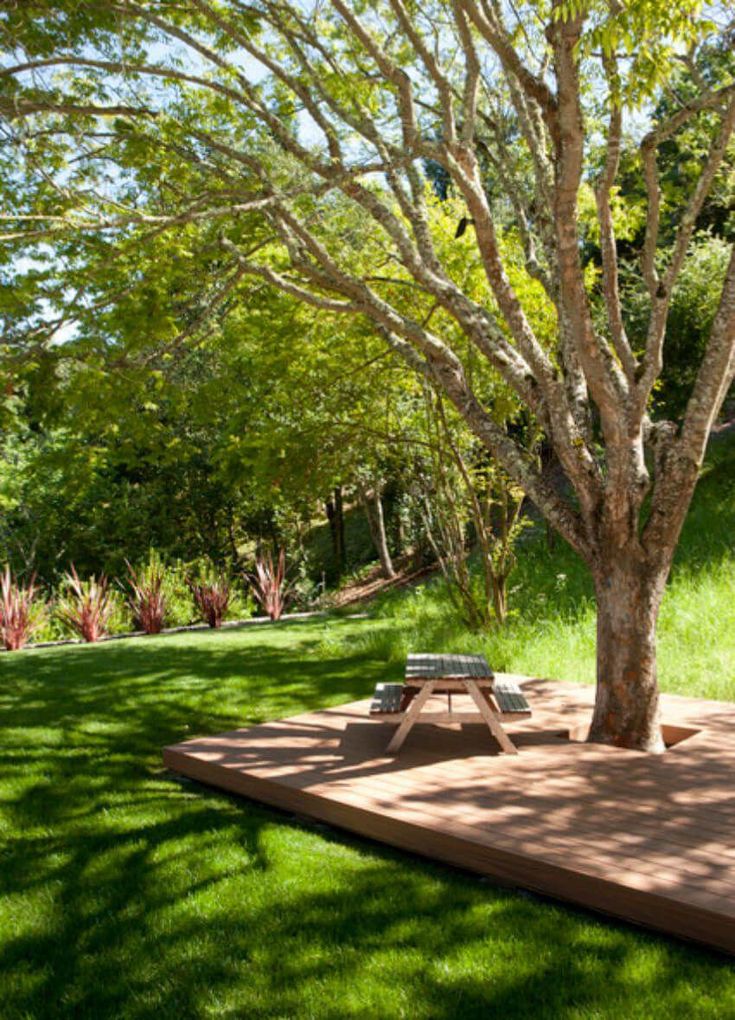 Their leaves provide year-round interest and can be found in assorted colors, like orange, scarlet, yellow, and bright green.
Their leaves provide year-round interest and can be found in assorted colors, like orange, scarlet, yellow, and bright green. Heucheras (coral bells) are compact perennials with roundish leaves that have scalloped edges. Grown for their colorful foliage, Heucheras are striking in rock gardens, in front of shrubs, as masses in borders, and in containers. Colors include light and medium green, deep red, orange, and variegated varieties.
-
03 of 15
A Tree With a Deck
Tim Davies LandscapingWhat do you do with a mature tree in the backyard with wide-spreading limbs? Instead of leaving the area below the tree bare, Tim Davies Landscaping built a deck around it. That gives the homeowners of this property in Floreat, Australia, more space to enjoy their yard and provides a stunning showcase for the architectural branches of the tree.
Is It Healthy for the Tree?
Building a patio or deck around a tree can actually help it, according to Austin Tree Experts.
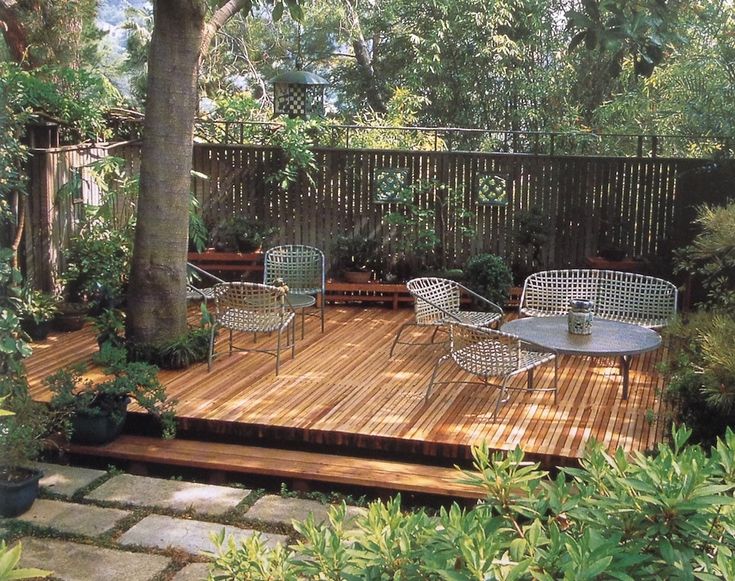 Among the benefits of a wood deck surround:
Among the benefits of a wood deck surround: - Reduced soil compaction to the tree's root zone. Years of compaction by foot traffic can be a stressor. A deck provides a buffer or completely eliminates compaction.
- Elevated wood decks get rid of foot traffic on soil under trees.
- Small gaps between planks allow water and oxygen to easily access the soil and roots.
- Leaves will still be able to slip through the board cracks, recycling nutrients back into the soil.
-
04 of 15
A Tree Grows in Brooklyn
Flo's GardensIn a corner of a cut-stone paved yard in Brooklyn, a mature plum tree provides shade and seasonal color. Flo's Gardens designed a low stacked stone raised bed contains the tree, which is underplanted with shade-tolerant hostas and firecracker plant 'St. Elmo's Fire'.
Deciduous flowering plum trees produce stunning floral displays in winter or spring. Some also produce fall color, like deep, smoky purples.

-
05 of 15
Oaks and Nettles
Donna Lynn Landscape DesignA sandstone cobble border makes a planer for these coast live oaks at a home near Santa Barbara, California. Created by Donna Lynn Landscape Design, the space was underplanted with silvery spotted dead nettle (Lamium maculatum) and edged with spreading bugleweed (Ajuga reptans).
Despite the name, dead nettles are very much alive. Natives of Europe and Western Asia, these vigorous growers have tooth-edged leaves and produce flower clusters in white, pink, or yellow.
-
06 of 15
Under the Aloe Tree
Michael Romero/Succulent Designs LAA heat-loving South African tree aloe (Aloe bainesii) is surrounded by large stones, rocks, and gravel, along with golden barrel cactus in this garden designed by Succulent Designs LA. Aloes and other succulents create a natural, beautiful setting. This multi-branched tree has a massive trunk and performs well in Mediterranean gardens.
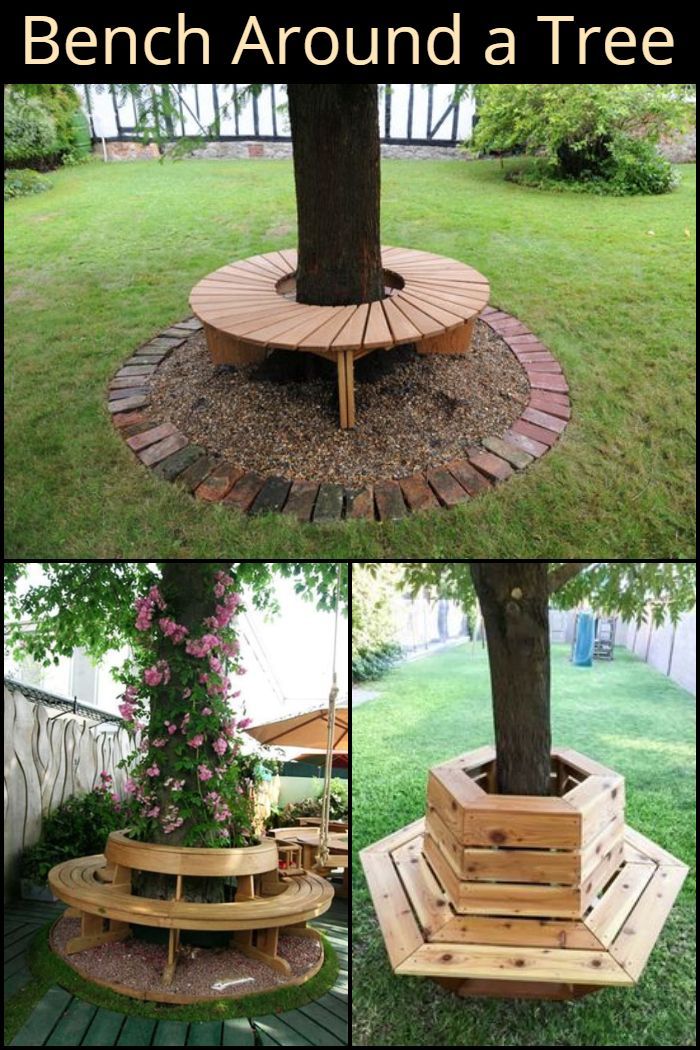 While it's a fast grower and is drought tolerant, the tree aloe likes water and good-draining soil, along with compost.
While it's a fast grower and is drought tolerant, the tree aloe likes water and good-draining soil, along with compost. -
07 of 15
Courtyard Tree
Jack Coyier/EPT DesignA silk floss tree (Chorisia speciosa) is underplanted with foxtail ferns and a no-mow, grasslike, ground cover. Created by EPT Design, a low concrete bench acts as a retaining wall for this tree. Its rectangular shape is repeated in the long pavers that stretch on a sea of river rocks. Plants behind the ferns are tropical cannas; to the right are drought-tolerant Agave attenuata.
-
08 of 15
Vineyard Property
Carson Joyce DouglasOlive trees at a California vineyard home are underplanted with sesleria 'Greenlee', olea 'Little Ollie', Westringia fruticosa 'Smokey', and artemisia 'David's Choice'. Designed by Carson Douglas Landscape Architecture, this driveway area was mulched with a native redwood. Santa Barbara sandstone boulders add textural interest.
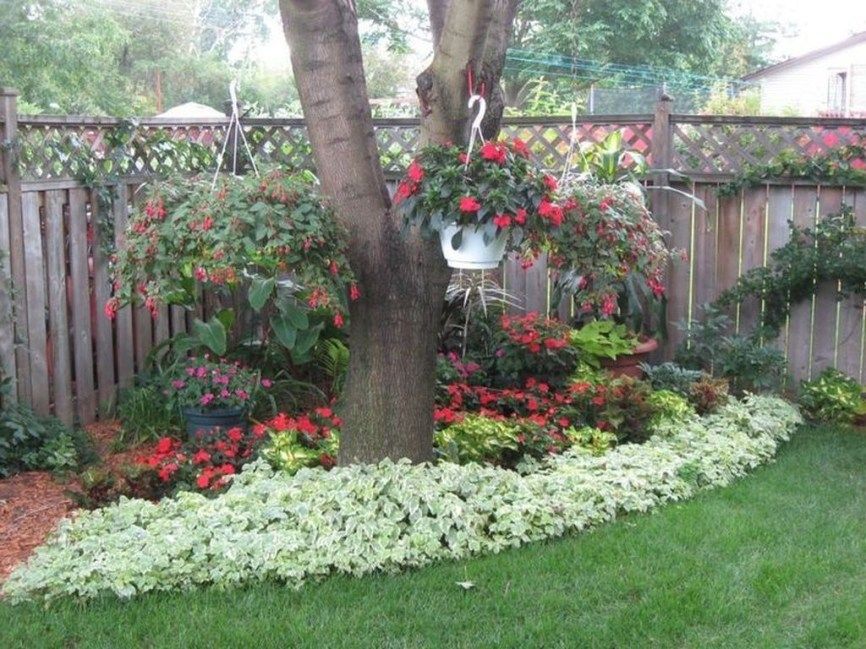
The olive trees, Olea europaea, are Mediterranean natives that grow well in California and parts of southern Arizona. They were introduced to mission gardens hundreds of years ago and prized for the oil that the fruit produces. These slow growers are most attractive when grown in deep, rich soil. If bothered by the sometimes-messy fruit crop, olive trees can be thinned each year, which also displays their striking branch patterns.
-
09 of 15
Rustic Garden
Carson Douglas Landscape ArchitectureRustic Corten steel planter edging holds a raised bed that includes this central multi-trunk olive tree along with assorted local stones and rocks. Other plants include carex and Sedum spectabile 'Autumn Joy'. along with native grasses. Designed by Carson Douglas Landscape Architecture, the property is in Alpine, California, inland to San Diego.
-
10 of 15
Shade Trees
James Theisen/Hively LandscapesThe beds of this formal, tree-lined path are livened up with lime green hostas and white-blooming shrubs.
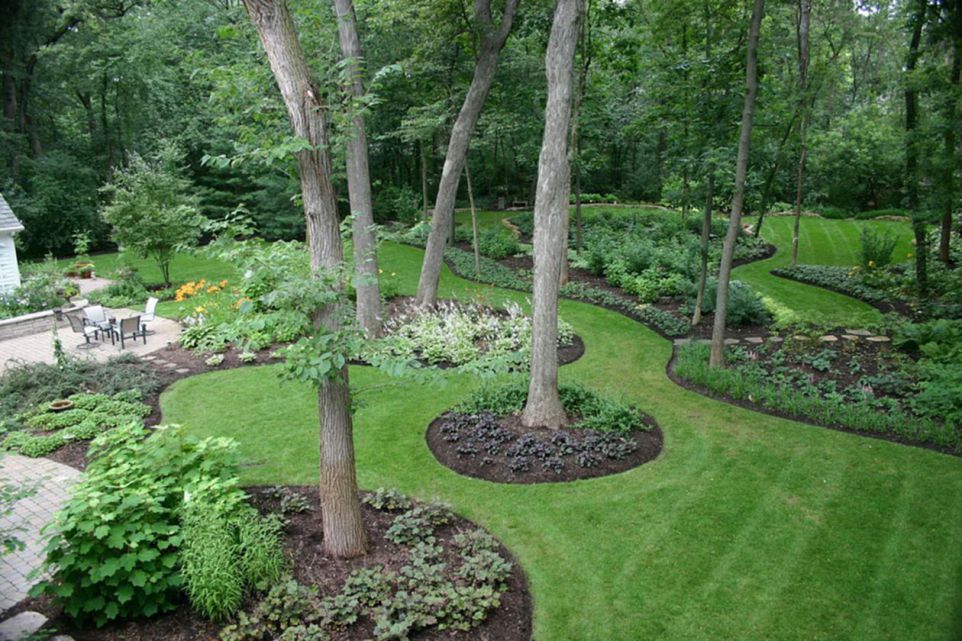 Hively Landscape Design of Dover, Pennsylvania, added shade-lovers like hostas and rhododendrons that always do well under the canopies of trees, especially if they are pruned and maintained.
Hively Landscape Design of Dover, Pennsylvania, added shade-lovers like hostas and rhododendrons that always do well under the canopies of trees, especially if they are pruned and maintained. -
11 of 15
London Back Garden
John DaviesA small outdoor roof terrace in Central London's new section of Swiss Cottage was given a contemporary look by John Davies Landscape Design. Inspired by New York's High Line, Davies envisioned the spaces as gardens in the sky that provide private and luxurious spaces for relaxation. Trees are planted in basalt terraces and include Japanese maple (Acer palmatum) and Osmanthus burkwoodii. The Osmanthus is pruned and trained into an umbrella form for a neat, manicured look.
-
12 of 15
Patio Trees
SCA-LARC/ HouzzA mature tree in the corner of this peaceful yard in Sherman Oaks, California, became part of a raised flagstone patio. Designed by SCA-LARC, the space is also used for a portable barbecue and keeps the space from getting soggy or neglected.
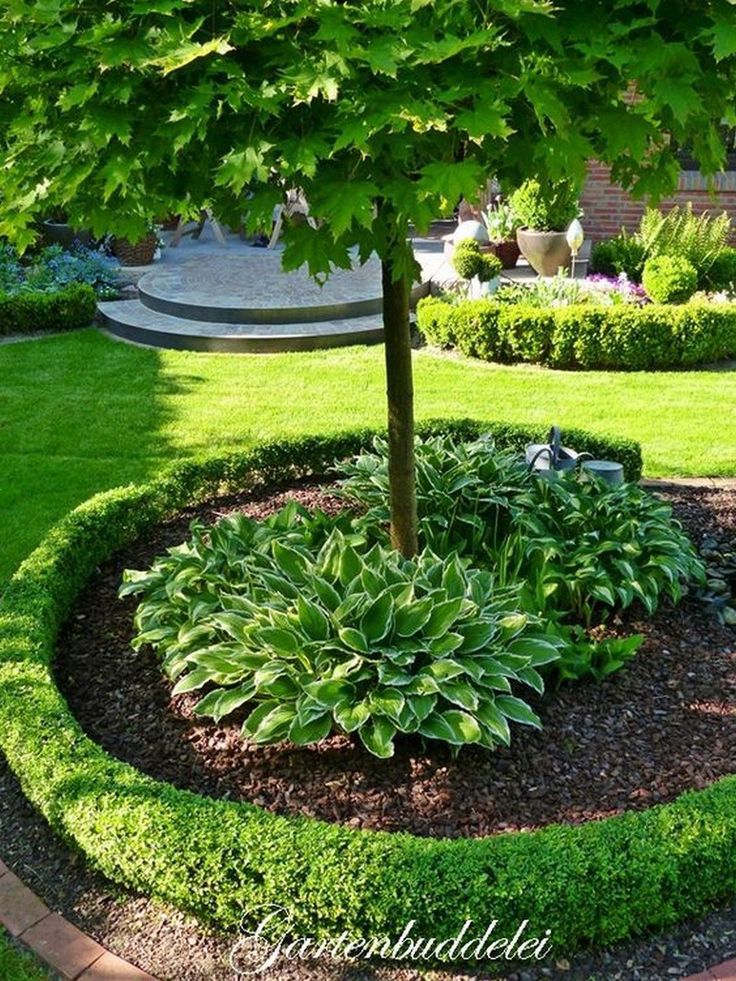 Tying it all together are paths of flagstone pavers that edge the garden borders and direct the flow of traffic throughout the yard.
Tying it all together are paths of flagstone pavers that edge the garden borders and direct the flow of traffic throughout the yard. -
13 of 15
Tree Deck
J. Michael Tucker/Ohashi Design StudioBuilding a deck to incorporate two serpentine oak trees gave this house near Oakland, California, more privacy. Instead of removing the oaks, ODS Architecture created a seamless indoor/outdoor experience and added more living space.
-
14 of 15
Mature Olive Trees
Garden of Eva/ HouzzMature olive trees in this Los Angeles backyard are surrounded by gravel and a thick carpet of lawn and more pea gravel for excellent drainage. Designed by Garden of Eva, the yard is filled with drought-tolerant plants and hardscape. Trees are affected by drought and owners often fail to water them, thinking that established specimens will survive. Young trees should be watered twice per week, while established trees should be watered directly beneath the foliage and canopy.
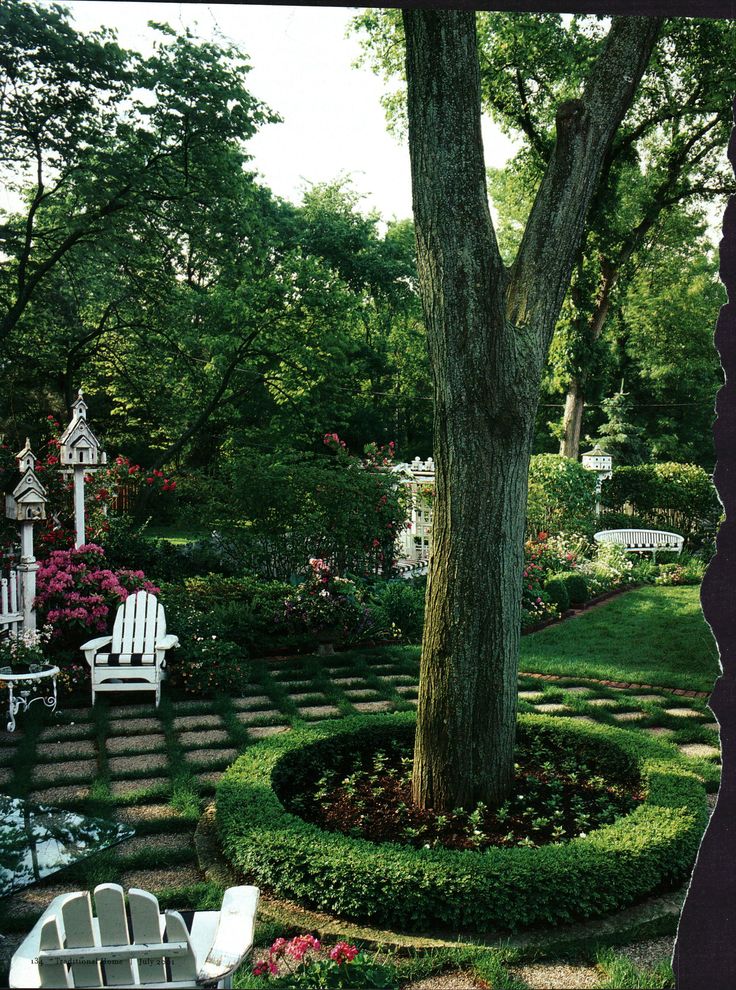 Also, apply mulch to retain much-needed moisture.
Also, apply mulch to retain much-needed moisture. -
15 of 15
Cottage Garden
Lisa Hallett TaylorA whimsical cottage garden in Orange, California, includes lots of details in its landscape design. Every free space of dirt is used for planting carefully chosen perennials, vines, and bulbs, along with garden statuary and ornaments. Soil is amended and rich for the variety of specimens in each bed.
The best ideas for renovating an old backyard garden
Got a house with an old neglected garden? Take your time to uproot trees, especially if they are healthy, flowering and bearing fruit. They can be ennobled, trimmed and easily fit into a new landscape.
Follow us:
Lonely tree
Lonely large tree can effectively rise above the lawn in front of the house. Surrounded by other perennials and flowers, it will highlight the variegated variety of plants, draw attention to the neatly trimmed shrubs along the paths or porch.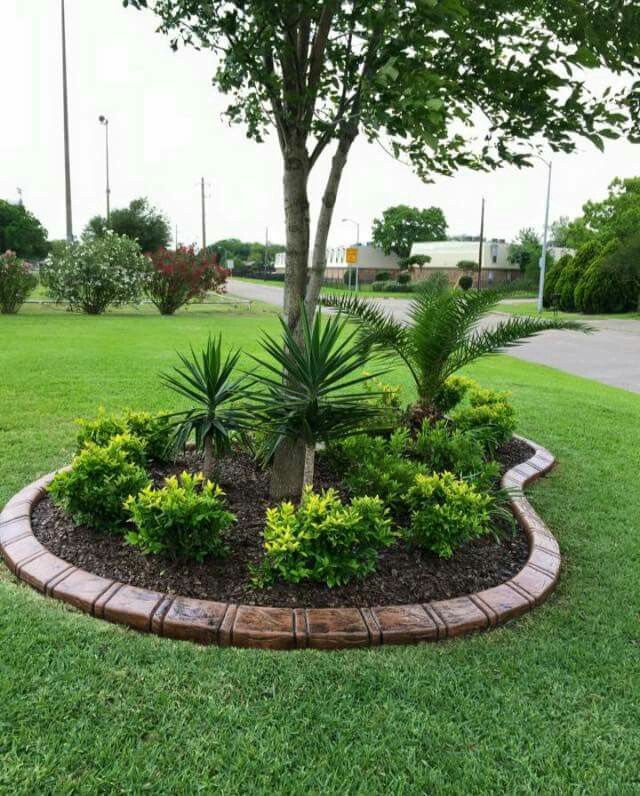 nine0005
nine0005
Spreading crown - a bright accent for geometrically regular garden shapes
Landscaping project
site design by Sad-dizain
More
Place for recreation hammock chair or children's swing. Mature trees, thanks to the developed crown, create a dense shadow. Under their shadow, you can create romantic corners in the garden.
Garden hammocks can be hung from the trunk or branches of a large tree
If the resting place is hidden behind a hedge, a green gazebo or a pergola, the corner will become more picturesque, and the site itself will seem much larger from the outside.
Decorating Shaded Areas
The area under tall trees is sure to be neat and attractive. To do this, plant a lawn with shade-loving shrubs and herbaceous crops. Blooming flower beds are laid out around the trunks.
A mini-pond with stones between old trees will create the illusion of wild, untouched nature
Places where nothing grows due to low light are covered with gravel or tiled.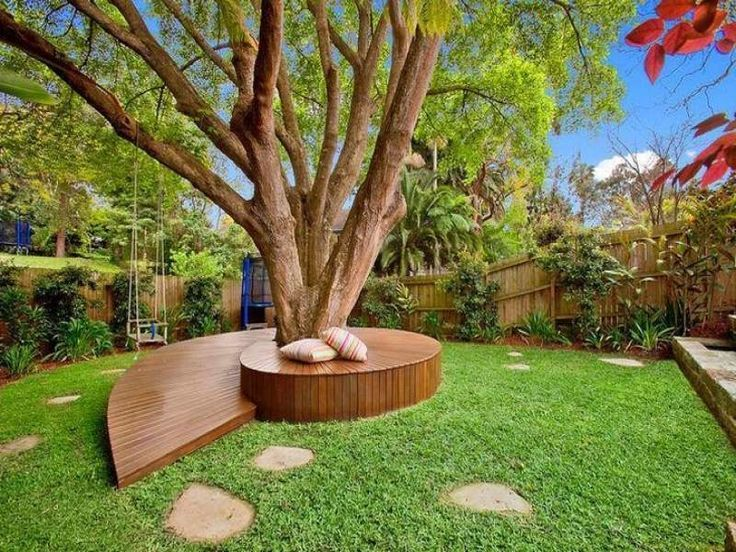 Nearby set a garden table with chairs for family leisure. At the same time, the number of design options is limited only by the imagination and personal preferences of the owners.
Nearby set a garden table with chairs for family leisure. At the same time, the number of design options is limited only by the imagination and personal preferences of the owners.
In the old garden there is always a place for a cozy family patio
An interesting garden cover - tree bark. It will help create a place for quiet contemplation. The perfect touch to her is a small bench for meditation. nine0005
Small boulders and gravel are used here to create a decorative path
Attention to detail
With a couple of large trees, you can create an oval mini-garden in the garden. In the center is a paved path that leads straight to the garden house.
Miniature plants do not block paths
Seating area
Even around the thinnest tree, a bench will be appropriate. Several resting places are set at an angle, in the form of a hexagon, rectangle, circle and even a semicircle. Available in various sizes, with and without backrest. To enhance the effect, the space in the center of the bench is increased.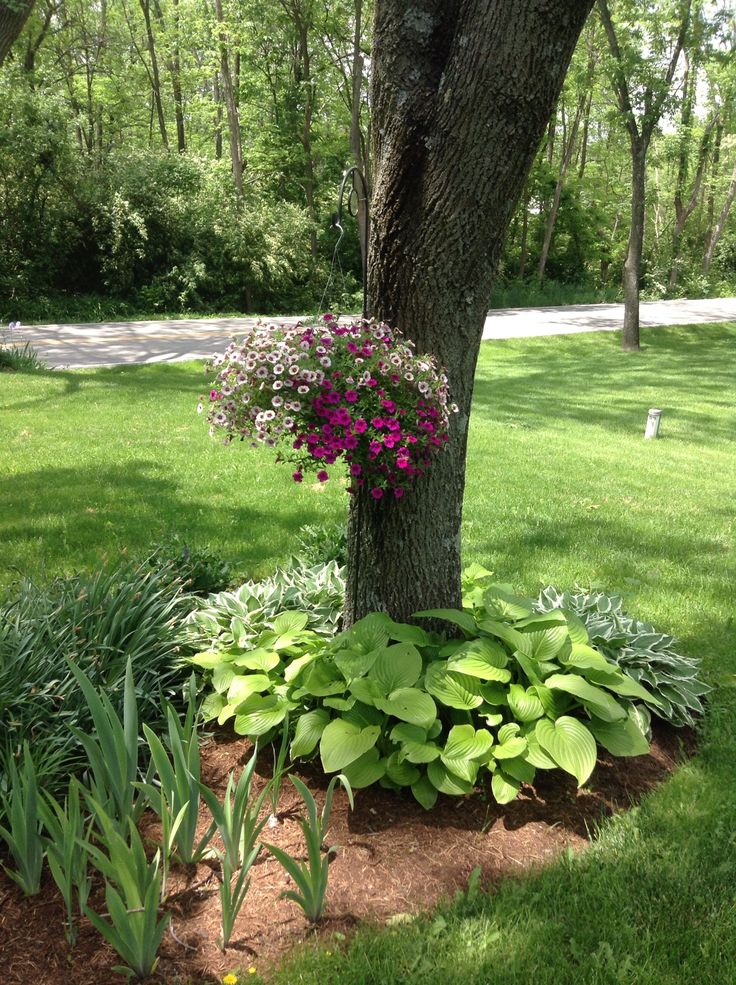 nine0005
nine0005
Highlight one of the garden's trees with a beautifully sanded bench
Landscaping project
from Sad-dizain
More details
Treehouse
Children will be delighted with a small wooden house on low stilts, partially supported by a huge tree. The slide, suspension bridges, ladders and swings are attached to its strongest branches. For safety, high reliable railings are placed around the perimeter, and soft mulch is scattered below.
To build a children's house, you need a strong tree with branches growing at an angle
Any questions? Not sure how to play with old trees in your landscaping? Contact us and we will be happy to help you do this.
Fruit trees in garden landscaping
Not a single suburban area can be imagined without fruit trees and shrubs. Many grow them for various preparations for the winter, and someone just loves to eat fresh fruits and berries grown by themselves.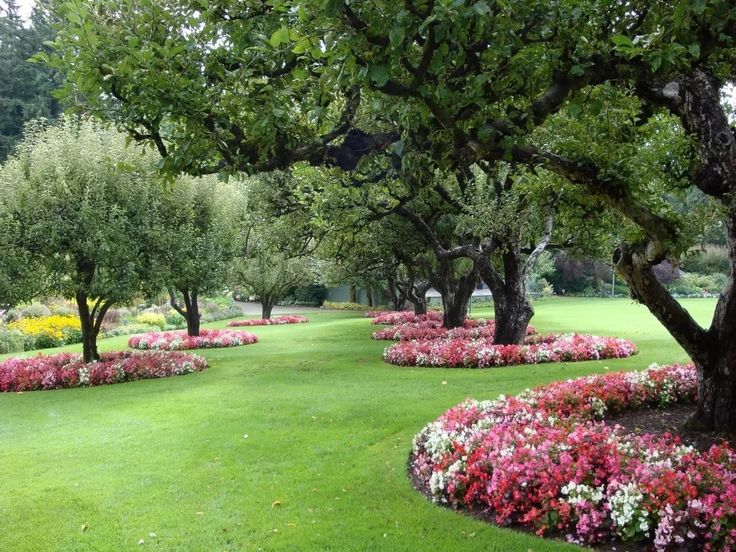 Despite preferences, fruit trees are irreplaceable and delight us with an abundance of vitamins and nutrients. nine0005
Despite preferences, fruit trees are irreplaceable and delight us with an abundance of vitamins and nutrients. nine0005
It doesn’t matter if you already have fruit trees or you are just starting to ennoble the site, you probably wondered: “How to plant fruit trees so that they not only please the crops, but also make the site attractive.” Decorating an orchard is not the easiest thing to do, but we hope that our article will help you with this.
Before you start decorating the garden, you need to decide, first of all, which fruit trees for the garden will decorate your site. If you look into our catalog of fruit trees, you will see numerous types of fruit trees: here is the well-known apple tree, and the pear, beloved by many cherries, cherry plums, plums, and even apricots. Thanks to our seasonal promotion for fruit trees and shrubs, you can choose everything that you so wanted to plant. All seedlings that are presented on our trading floor are suitable for growing in the Moscow region.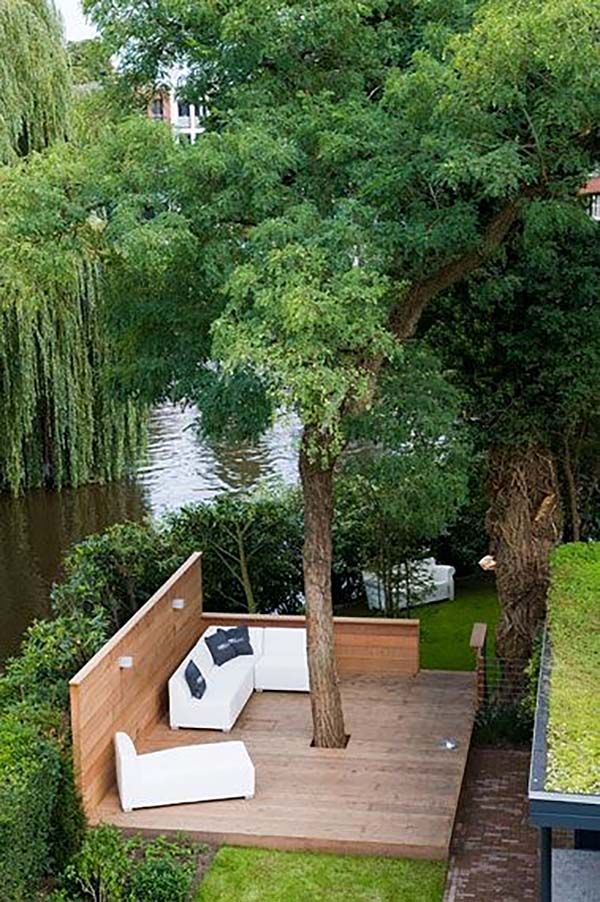 nine0005
nine0005
Once you have decided on the species and varieties, it's time to plant them on the site. If we recall the fruit trees that were grown in the gardens by our grandparents, powerful, overgrown trees appear before our eyes, which fill the entire space around them. Of course, modern varieties of fruit trees also require space, but nowadays many popular fruit trees are grafted onto dwarf rootstocks, which saves space in the garden. Despite such innovations, it is impossible to simply randomly plant seedlings around the site and get a decorative orchard. nine0005
In landscape design, there are special schemes for orchards: trees can be planted in an alley, triangles according to species difference (3 plums, 3 cherries in a triangle) or in a circle. Your choice depends only on the size of the site and style. When planting fruit trees, it is recommended not to mix stone fruits with pome fruits: for example, plant cherries and pears side by side. This is due to the peculiarities of the root system - it is too different for them.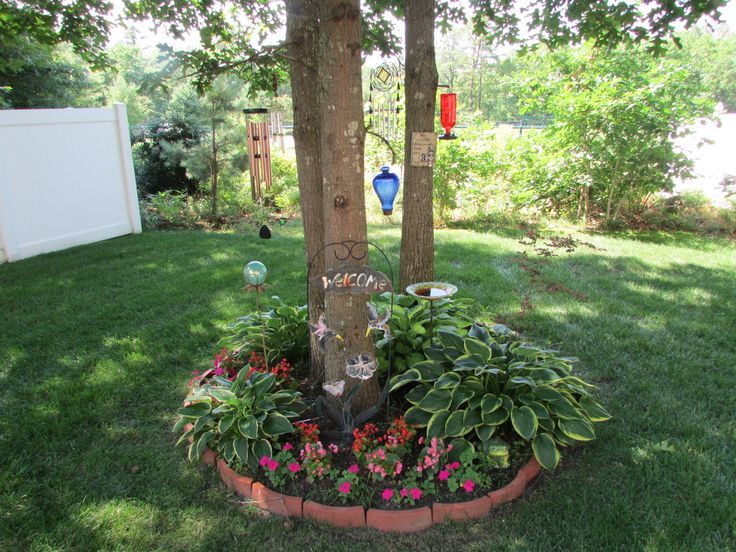 At the same time, for example, cherries grow well next to plums. And a good neighbor for a pear is a mountain ash. Speaking of rowan. Breeding does not stand still and today a lot of new varieties have been bred, different in color, taste and size of fruits. nine0005
At the same time, for example, cherries grow well next to plums. And a good neighbor for a pear is a mountain ash. Speaking of rowan. Breeding does not stand still and today a lot of new varieties have been bred, different in color, taste and size of fruits. nine0005
If you have chosen a circular or triangular fruit planting pattern, you can place a table with an armchair or a bench in it. Just imagine how beautiful it is in spring, when the gardens are blooming and you are sitting with a cup of hot tea in your hands, enjoying nature.
If you have little space on the site, you can plant fruit plants directly into the landscape jigging. For example, you can plant an apple tree next to a maple and linden, just stepping back a couple of meters from them (so that later they do not interfere with each other). You can decorate such a composition with a decorative vesicle and derain with a variegated leaf, sea buckthorn, chokeberry (chokeberry). nine0005
In the same planting, if desired, you can plant an ornamental apple tree, for example, varieties Koktsinela, Rudolf, Ola.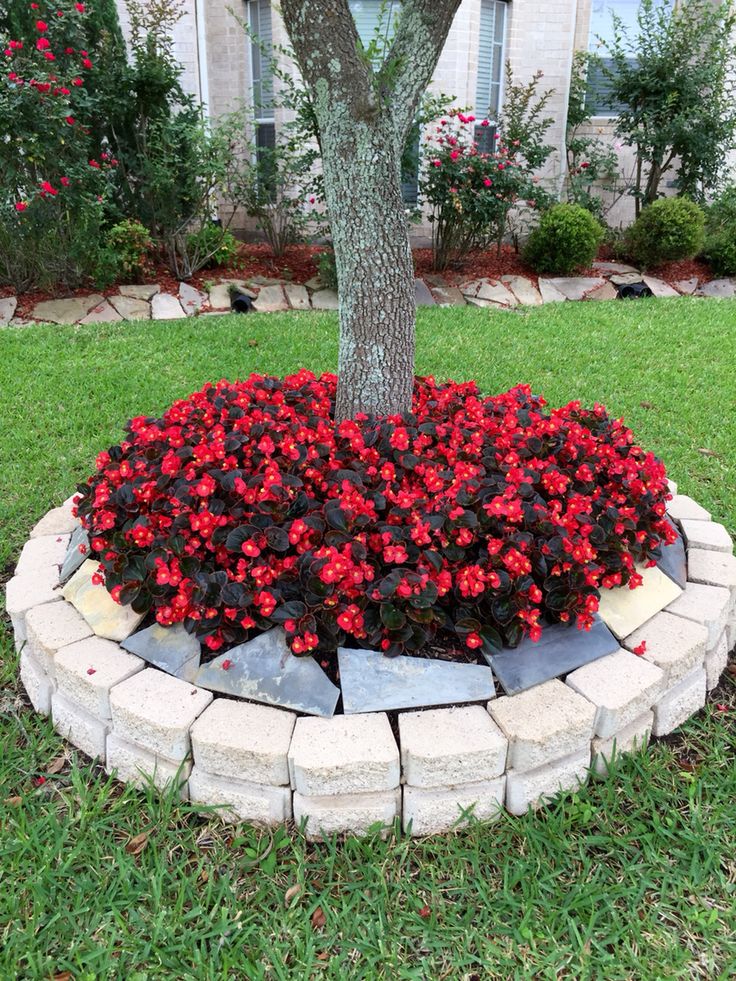 They look great for almost the entire season, sometimes delighting with delicate spring fragrant flowers, sometimes with decorative amazing and small apples.
They look great for almost the entire season, sometimes delighting with delicate spring fragrant flowers, sometimes with decorative amazing and small apples.
If you have already planted fruit trees, to create an ornamental garden, decorative and deciduous shrubs will definitely help you. Since fruit crops require a sufficient amount of light, their neighbors must also be sun-loving. All kinds of derains, vesicles, viburnums, mock oranges, sea buckthorn - all of them will advantageously cover the bare trunk of a fruit tree and emphasize it with their decorative foliage. When framing fruit trees with ornamental shrubs, it is necessary to maintain a distance of at least two meters to avoid thickening. nine0005
In order for a decorative orchard to please you for many years, it is necessary to maintain it in a well-groomed condition. Formative pruning of fruit trees and shrubs will help with this. Thanks to it, the decorative effect of the entire composition is preserved, and fruiting becomes longer and more abundant.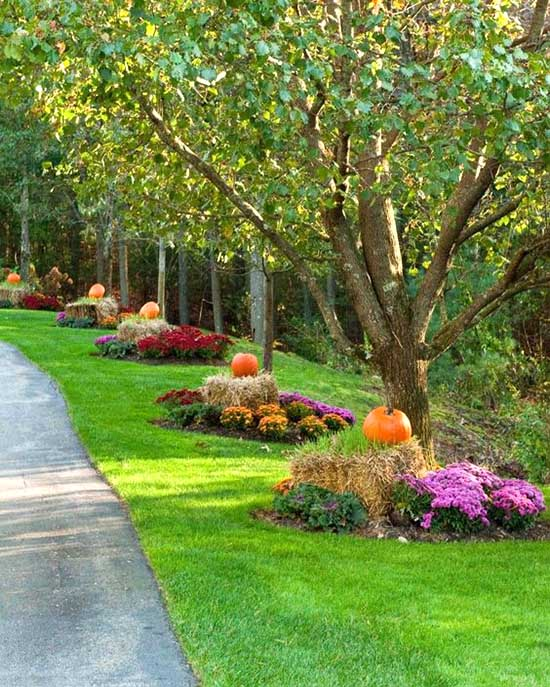
Another simple trick that will help add neatness and comfort to your garden is the design of tree trunks. They can be framed with a border tape, and annual flowers can be planted in the circle itself. nine0005
Also, nowadays there are all kinds of round benches that can surround a fruit tree, together creating a cozy shady place to relax. When designing an orchard, do not forget about garden sculptures as well, they are completely different in shape and size.
Of course, you can just plant an orchard and enjoy the fruits, but with proper planning, there is every chance of creating a decorative and unique resting place on your site where your family and guests will gather. nine0015
Share on social networks:
What kind of sweet cherry to choose for your plot?
02.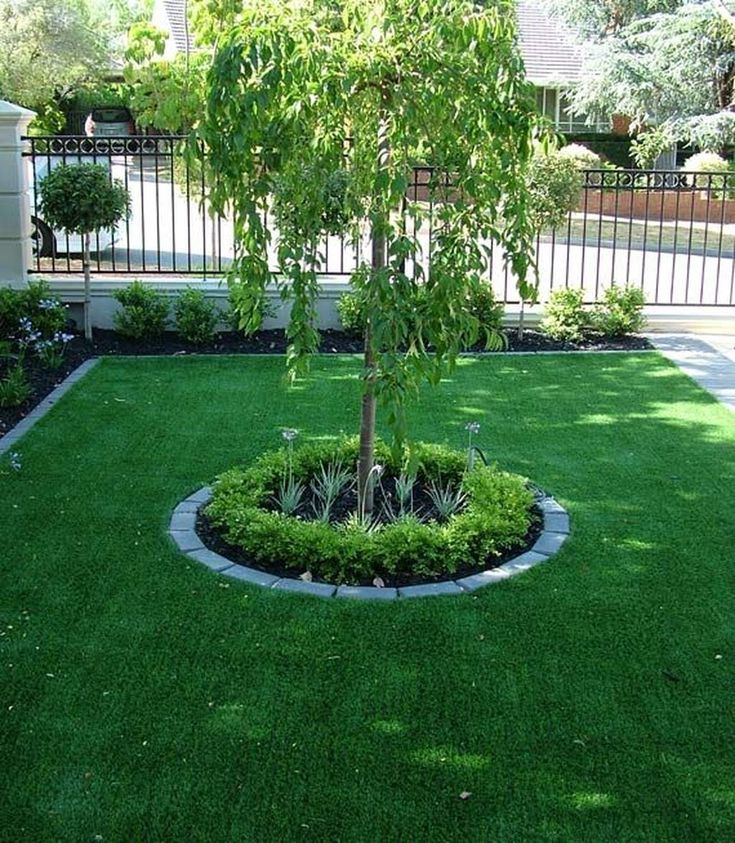 05.2019 Articles
05.2019 Articles
Honeysuckle: useful properties, planting, varieties with a description
02.05.2019Articles
Read next article07.12.2022 Articles
Deciduous ornamental garden trees with a compact crown
Planning a small area is an art. What to do when you want to place buildings, a garden, and a beautiful recreation area with familiar deciduous plants? Choose the right varieties. nine0005
In this article, we will talk about which seedlings of ornamental plants to choose for a compact plot and how best to place them.